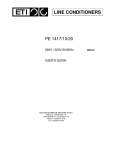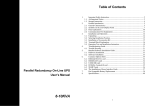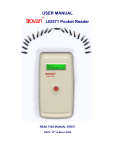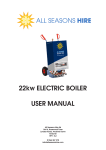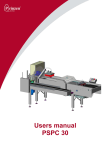Download LINE CONDITIONERS
Transcript
LINE CONDITIONERS PE 1418/10/20 220V / 220V-50/60Hz USER'S GUIDE ELECTROTECHNISCHE INDUSTRIE ETI B.V. Postbus 56, 7120 AB Aalten - NL Vierde Broekdijk 16, 7122 JD Aalten - NL Telefoon +31(0)543 47 24 31 Fax +31(0)543 47 54 25 4500VA GENERAL 2.1.2. INPUT 1. INTRODUCTION Mains voltage (a.c.) nominal 220 V (198 V - 242 V) or 240 V (218 V -266 V) by wiring The PE 1418/10 (OEM or open-version) and PE 1418/20 (closed version) are line conditioners which deliver a sinewave output with galvanic separation between input and output. The output is short-circuit proof. Several stabilizers of the same type may be connected in parallel or in a three-phase configuration. Mains frequency 50 Hz (t 2 %) or 60 Hz (t 2 %) by wiring Consumption, input current Type Im (1) Fuses (2) PE 1418/10 PE 1418/20 26 A 26 A 50 A 50 A NOTE : The design of this stabilizer is subject to de- and improvement. Consequently, this stabilizer may incorporate minor changes in detail from the information contained in this manual. Only values with tolerances or limits can be considered as guaranteed data. Figures without tolerances are informative data without guarantee. (1) at mains voltage of 220 V (2) the delayed action fuses, provided by the user, are to be mounted outside the stabilizer. 2. CHARACTERISTICS Efficiency (at full load) PE 1418/10 : min. 89 % PE 1418/20 : min. 89 % This section deals with the technical specifications of the stabilizer with regard to the input and output conditions (i.e. amplitudes, regulation, stability, etc.) safety aspects and interference level. In addition, it covers details of environmental and mechanical data, and gives a list of accessories that are provided with the stabilizer. ON DELIVERY Type PE 1418/10 PE 1418/20 2.1. ELECTRICAL DATA Type The values given in this section are valid within the rated range of operation (- I0°C to + 35°C). On deli very, the stabilizer is adjusted at an ambient temperature of 23'C, with convection cooling. PE 1418/10 PE 1418/20 wired as STABILIZER STABILIZER INPUT 220V/50Hz 220V/50Hz OUTPUT 220 V 220 V PQ (VA) Um(V) U (V) fm (Hz) 4500 4500 220/240 220/240 220/240 220/240 50/60 50/60 2.1.4. OUTPUT EFFECTS 2.1.1. GENERAL 2.1.4.1. As stabilizer * Safety. In accordance with (Safety class 1) IEC 65, IEC 348, IE C 380, IEC 435 VDE 550 : only for the transformers Leakage current (from chassis to earth) max. 0,5 mA r.m.s. at 50 Hz (on delivery) * Dielectric strength test. Every unit has been factory tested to withstand the following voltages - between primary and chassis - primary and secondary - secondary and chassis Output voltage nominal value Uon: 220 V (+ 1, - 1) % or 240 V (+ 2, -2) % * Source effect (Um : + 10 % or - 10 %) Valid for a constant mains frequency of 50 Hz, an input distortion of max. 5 % and a linear resistive load between no load and full load. max. -1 %, + 1 % * : 2,0 kVa.c. : 2,5 kVa.c. : 2,0 kVa.c. In the event of repetition of the dielectric strength tests, it is necessary to follow the instructions laid down in the Service Manual. If the Service Manual is not in stock ETI must be contacted in order to obtain the supplementary information. * Combined load and source effect : Valid for a constant mains frequency of 50 Hz, an input distortion of max. 5 %, a mains input voltage between + 10 % and - 10 % and a linear resistive load between no load and full load. max. - 1,5 %, + 2,3 % from Uon Warm-up time : 4 hours with a cold core (+ 25°C), the output voltage is approximatively 1,5 % higher. * Output terminals : the output terminals are floating with respect to earth. The voltage between any one of the output terminals and earth may not exceed 500 V a.c. (r.m.s.). * Noise level. PE 1418/10 : max. 50 dBA PE 1418/20 : max. 50 dBA PE 1418/10/20 2 * Distortion (output) max. 4 % under all conditions referred to under source and load effect. COOLING * Source frequency effect (fm : 50Hz ± 2% or 60Hz ± 2%) For each 1 % mains frequency variation, the max. output variation is 1,5 % - The ambient temperature is defined as the temperature 20 mm below the unit. Mount the power supply unit with the cooling surfaces in a vertical plane so that the air circulation in the unit is maximum. - The current values given in Section 2.1.3. may be only applied when the unit is in a free-standing position and the rising warmed air is not impeded. 2.1.4.2. As filter 2.2.2. ENVIRONMENTAL TESTS * Output voltage nominal value Uon 220 V (+ 1, - 1) % or 240 V (+ 2, -2) % Performance tests, operating * Transient suppression min. 40 dB for asymmetrical pulses * Source effect (Um : + 10 % or - 10 %) Valid for a constant mains frequency of 50 Hz, an input distortion of max. 5 % and a linear resistive load between no load and full load. max. -2 %, + 2 % * Combined load and source effect Valid for a constant mains frequency of 50 Hz, an input distortion of max. 5 %, a mains input voltage between + 10 % and - 10 % and a linear resistive load between no load and full load. max. - 2,1 %, + 4,5 % from Uon * Warm-up time : 4 hours with a cold core (+ 25°C), the output voltage is approximatively 1,5 % higher. Description Cold test Dry heat Damp heat steady state Tests for storage and transport Description Cold test Dry heat Vibration test Bump test Cyclic damp heat test Packaging * Distortion (output) max. 4 % under all conditions referred to under source and load effect. IEC-68 2-1 Ad 2 h. (-20°C) 2-2 Bd 2 h. (+40°C) 2-3 Ca 10 d.(+45°C) IEC-68 2-1 Ab 72 h.(-40°C) 2-2 Bd 96 h.(+70°C) 2-6 Fc 2-29 Eb 2-30 Db 21 d.(+25°C to + 40°C) 90 - 100 % RH according to UN-D-1400 The test methods mentioned are in accordance with those of the relevant ISO-Standards. * Transient suppression min. 60 dB for asymmetrical pulses Source frequency effect (fm : 50Hz ± 2% or 60Hz ± 2%) For each 1 % mains frequency variation, the max. output variation is 1,5 % 2.3. MECHANICAL DATA 2.3.1. OVERALL DIMENSIONS AND WEIGHT (see also page 12) 2.1.5. PROTECTION Overcurrent Short-circuit current : natural limitation of transformer with leakage flux path. : between 150 % and 200 % 2.2 ENVIRONMENTAL DATA The environmental data mentioned in this manual are based on the results of the manufacturer's checking procedures. 2.2.1. CLIMATIC CONDITIONS Designation Type PE 1418/10 PE 1418/20 -Ambient temperature -rated range of use : (-10/+45)°C -limit range of operation : (-20/+45)°C -limit range for storage/transport : (-40/+70)°C PE 1418/10 PE 1418/20 Height Width Depth Mass 694 mm 480 mm 470 mm 112 kg : : : : 692 mm 447 mm 447 mm 106 kg 2.3.2. MOUNTING Connecting Block X10 : INPUT X11 : OUTPUT X12 : EARTH 2.4. ACCESSORIES (-10/+35)°C (-20/+35)°C (-40/+70)°C 2.4.1. OPERATING MANUAL Relative humidity (of the ambient air) non condensing ( 20/90) % (20/90 ) % 2.4.2. OPTIONAL Not applicable 3 PE1418/10/20 STAB 220V (50HZ) /220V FIG. 220 FILT 220V (50HZ) /240V FIG. 222 FILT 220V (50HZ) /220V FIG. 221 FILT 240V (50HZ) /220V FIG. 223 FILT 240V(50HZ)/240V FIG. 224 PE 1418/10/20 4 STAB 220V (60HZ) /220V Fig. 225 FILT 220V (60HZ) /220V FIG. 227 FILT 220V (60HZ) /240V FIG. 229 PE 1418/10/20 STAB 240V (60HZ) /220V FIG. 226 FILT 240V (60HZ) /220V FIG. 228 FILT 240V (60HZ) /240V FIG. 230 5 TABLE 1 f 50 HZ 60 HZ m STAB/ FILTER STAB Um 220V Uon 220V FIG 220 PE 1418/10/20 FILT 220V 220V 221 STAB 240V 220V FILT 240V 220V 240V 240V 220V 240V 220V 220V 220V 240V 220V 240V 222 223 225 226 227 224 228 229 6 230 PE 1418/10/20 7 DIRECTIONS FOR USE The current-carrying wires to the mains must be of sufficient cross-section depending on the mains voltage and the distance between the mains and the stabilizer. 3. INSTALLATION 4. OPERATING INSTRUCTIONS 3.1. INITIAL INSPECTION Refer to Safety Precautions and Unpacking SEE WARNING A – PROTECTIVE EARTHING 3.2 MOUNTING INSTRUCTIONS Connect the stabilizer to a protective earth with M6 SEE WARNING A – PROTECTIVE EARTHING A line conditioner attains a nominal working temperature higher than a conventional transformer, due to the high flux density in the core. A physical spacing and/or orientation of the transformer field must be realized to avoid interactions with circuits like audio, CRT displays, etc ... 3.3. DISMANTLING Removal and access /10 version - the connecting blocks are accessible without dismantling /20 version - the connecting blocks are accessible after removing the cover 3.4. OUTPUT CONNECTION NOTE : The output effects given in Sect. 2.1.4. can be influenced by external connections or parameters (e.g. cross-sections of the load connections, distance between output terminals and load characteristics of the load. Max. cross-section GENERAL INFORMATION This section outlines the procedures and precautions necessary for operation. It identifies and briefly describes the functions of front and rear panel controls and indicators, and ex plains the practical aspects of operation to enable an operator to evaluate quickly the instrument's main functions. 4.2. SWITCHING "ON" After the stabilizer has been connected to the mains (line) voltage in accordance with Installation, Sections 3.1. and 3.6. it can be switched on, after which the instrument is ready for use. With normal installation, in accordance with Section 3 and after a warming-up time of 2 hours, the characteristics specified in Section 2 are valid. 4.3. SEE WARNING B - Before handling or dismantling first disconnect from all voltage sources. Connecting block Phase 4.1. CONTROLS,ADJUSTMENTS,INDICATORS AND TERMINALS (Fig. 101) Front panel : H1 indicates the presence of the output voltage (PE 1418/20) Rear : input cable inlet output cable inlet : Pg29 : Pg29 input connection block : X10 ( cross-section output connection block : X11 connecting block : X1 (transformers) earth terminal : X12 (M6) max 16 mm² – M5 ) 4.4. SERIES, PARALLEL AND THREE-PHASE CONNECTIONS 4.4.1. SERIES CONNECTION Not applicable : X1 : terminals U1 and V1 :16 mm² (M5) 4.4.2. PARALLEL CONNECTION The cross-section of the wires must b6 of adequate current-carrying capacity (also dependent on the distance between the line conditioner and the load). Stabilizer of the same type-may be connected in parallel; if for technical information, please contact ETI. 3.5. MAINS CONNECTION 4.4.3. THREE-PHASE CONNECTION Before inserting the mains plug into the mains socket, make sure that the instrument is set to the local mains voltage. NOTE : If the mains plug has to be adapted to the local situation, such adaptation should be done by a qualified person only ! See WARNING A - protective earthing. Page 12. See WARNING B - authorized mains connection & disconnection procedures. Page 12. See WARNING C - fuse types and renewal procedure. Page 12. See WARNING D - Page 12. Connect the power supply to the a.c. mains voltage (see also Sect. 5.2.) through connector Connecting block : terminals U and V max. cross-Section 16 mm² PE1418/10/20 Stabilizers of the same type may be connected in a three phase configuration ; for technical information, please contact ETI. 5. ADJUSTMENTS See WARNING B - adjustments by qualified person only. After switching off wait 4 minutes before handling. 5.1. GENERAL WARNING D : when changing the nominal values, the rating type-plate must be suitably amended. IMPORTANT : as all the transformers of one stabilizer are parallel connected, all single transformers must be identically wired to the chosen configuration. 8 5.2. MAINS INPUT On delivery, the stabilizer is wired for input voltage : 220 V mains frequency : 50 Hz configuration : as "STABILIZER" For other configurations, see Table 1. For 110 V mains connections, please contact ETI. 5.3. OUTPUT ADJUSTMENTS On delivery, the stabilizer is wired for output voltage : 220 V 50 Hz configuration : as "STABILIZER" For other configuration, see Table 1. 6. SERVICING See WARNING B ; Servicing by qualified person only ! For servicing, refer to the "Service Manual" which can be ordered from: ELECTROTECHNISCHE INDUSTRIE ETI B.V Postbus 56, 7120 AB Aalten - NL Vierde Broekdijk 16, 7122 JD Aalten - NL Telefoon +31(0)543 47 24 31 Fax +31(0)543 47 54 25 If other technical information is required, please contact : ELECTROTECHNISCHE INDUSTRIE ETI B.V Postbus 56, 7120 AB Aalten - NL Vierde Broekdijk 16, 7122 JD Aalten - NL Telefoon +31(0)543 47 24 31 Fax +31(0)543 47 54 25 Safety measures require that the instrument should first be put into its original state and that the spare parts are identical to the original components. The use of a mains-isolating transformer during service is necessary. 6.1. FUSE REPLACEMENT Not applicable PE1418/10/20 9 7. CLIMATIC CONDITIONS. -Ambient temperature PE1418/20 -rated range of use -10°C to + 35°C -limit range of operation -20°C to + 35°C -limit range for storage and transport -40°C to + 70°C -Humidity (ambient air, non condensing) : 20% to 90% PE1428/20 - Protection degree of the enclosure according to IEC 529 = IP20 PE1418/10/20 10 MOUNTING INSTRUCTIONS. 1. GENERAL. Disconnect device shall be provided to disconnect the equipment from the supply for servicing. If provided, the plug on the power supply cord is permitted as disconnect device For PERMANENTLY CONNECTED EQUIPMENT, a readily accessible disconnect device shall be incorporated in the fixed wiring. For PLUGGABLE EQUIPMENT, the socket-outlet shall be installed near the equipment and shall be easily accessible. A physical spacing and/or orientation of the line conditioner field must be realized to avoid interactions with circuits like audio, CRT displays, etc... To reduce EMI coupling, input and output cables must be separated. Max. cross-section of connecting block 16 mm2 Min. cross section of connecting leads 4,5 mm2 A line conditioner attains a nominal working temperature higher than a conventional transformer, due to the high flux density. 2. /20 VERSION The connecting blocks are accessible after removing the rear plate (4 screws). Use the included clips, screws and washers to place the cover. (1.fix the clips, 2.place the cover, 3.fix the cover) 3 Transit - Transport. Remove the cover (only for /20). Use lift rings to move the unit. PE1418/10/20 11 SAFETY PRECAUTIONS In the interests of safety to personnel and equipment, it is strongly recommended that this page is read and thoroughly understood by all intended users before at tempting to put this instrument into service. This apparatus has been manufactured according to safety Class 1 standards as listed in Sect. 2.1.1. and has been supplied in a safe condition. This manual contains information and warnings which must be followed by the user to ensure safe operation and to retain the apparatus in a safe condition. Where necessary, warning and caution statements and/or symbols are marked on the apparatus. CAUTION is used to indicate correct operating or maintenance procedures in order to prevent damage to or destruction of equipment or other property. WARNING calls attention to a potential danger that requires correct procedures or practices in order to prevent personal injury. SYMBOLS : Any interruption of the protective conductor inside or outside the apparatus, or disconnection of the protective earth terminal is likely to make the apparatus dangerous ; intentional interruption is prohibited. Impaired safety protection Whenever it is likely that safety-protection has been im paired, the instrument must be made inoperative and be secured against any operation. The matter should then be referred to the appropriate servicing authority. Safety protection is likely to be impaired if, for example, the instrument fails to perform the intended measurements or shows signs of damage. Important warnings : Wherever appropriate in the manual, four important warnings are inserted in short, reminder form to maintain subject continuity. However, if there is any doubt about their meaning, always refer to the detailed explanation below: WARNING A : Before any connection is made to a voltage source, the protective earth terminal shall be connected to a protective conductor. The stabilizer must be earthed in accordance with the IEC 348 safety regulations. When a stabilizer is brought from a cold to a warm environment, condensation may cause a hazardous condition ensure therefore that the earthing requirements are strictly adhered to. If a three-core mains cable with mains plug is used, the mains plus shall be inserted into a socket provided with a protective earth contact. The protective action shall not be negated by the use of an extension lead without protective conductor. The cross-section of the earth conductor must be at least equal to the cross-section of the mains conductors and in accordance with the local safety regulations. If the stabilizer is rack-mounted, the rack must be connected to the Safety Earth in accordance with IEC 348. The cross-section of the earth conductor must be sufficient and depending on the total power of all instruments mounted in this rack. WARNING B : After delivery, the apparatus must be connected to the power source only by a qualified person. Before making any connection, the safety measures must be thoroughly understood and observed. All adjustments, replacements, repairs, etc... shall be carried out by a qualified person aware of the hazards involved, with the instrument completely disconnected from the mains wher ever possible. After disconnection, allow 4 minutes for WARNINGC:For continued protection against fire only fuses with the required rated current and of the specified type shall be used for replacement; the use of repaired fuses and the short-circuiting of fuseholders is prohibited. The instrument shall be disconnected from all voltage sources when a fuse is to be replaced. As the stabilizer is electronically protected against most faults, a blown fuse indicates a major defect. Before re placing the fuse, always check the electronic circuit. UNPACKING on delivery, check the stabilizer as soon as possible to ascertain, whether any damage has occurred in transit. Retain all packing materials until all items of the power supply have been accounted for and checked. * Visual inspection Carry out a mechanical check on, e.g. connectors, terminal blocks, external fuse-holders and other enclosures. Check items for dents, chips or other signs of damage. Check that all accessories are present in accordance with the accessories list (Sect. 2.4). * Claims In the event of obvious damage or shortages, or if the safety of the stabilizer is suspect, a claim should be filed with the carrier immediately. ETI should also be notified in order to facilitate the repair of the instrument. WARNING D : If nominal values are changed, the rating type plate must be suitably amended. PE1418/10/20 12













